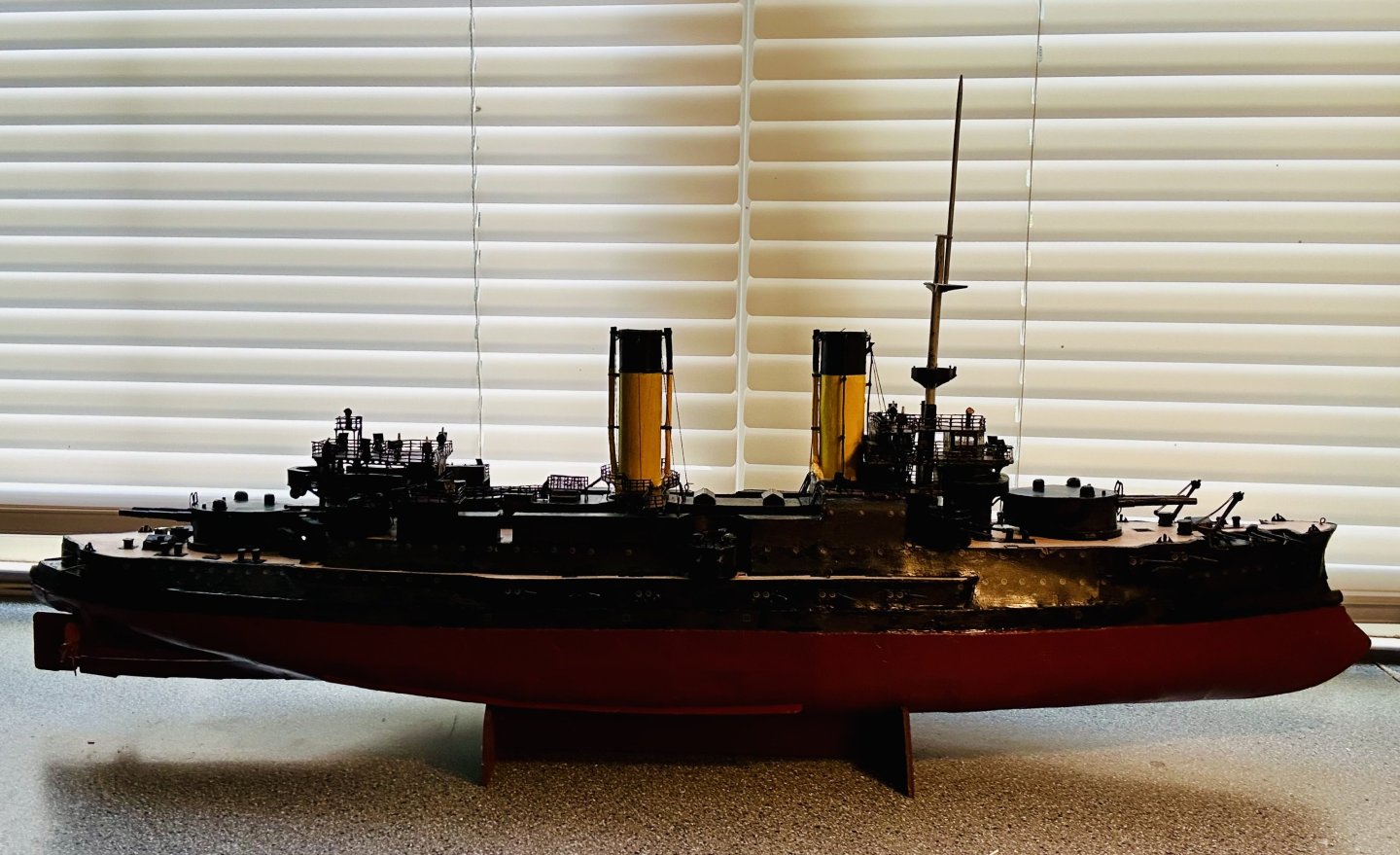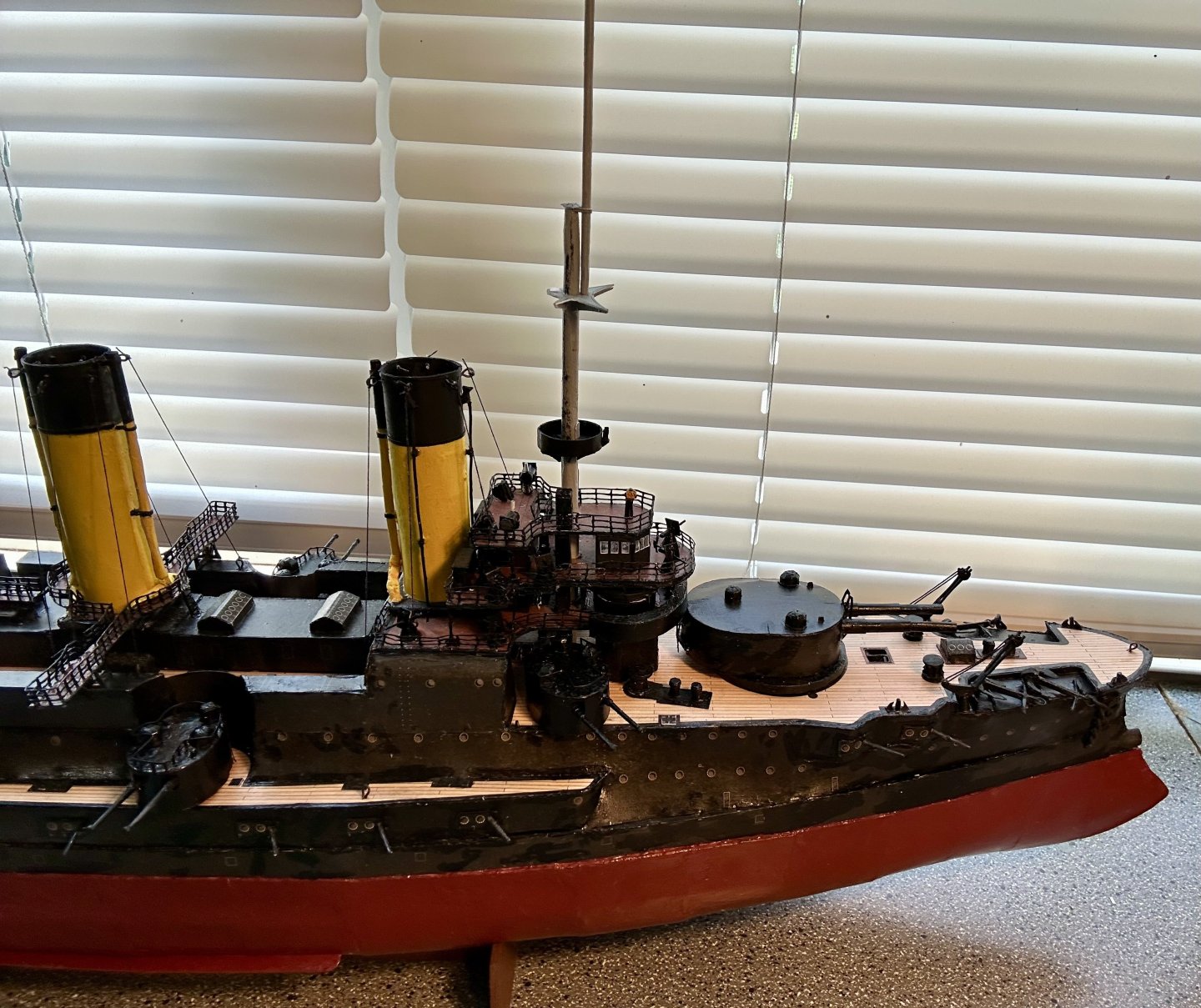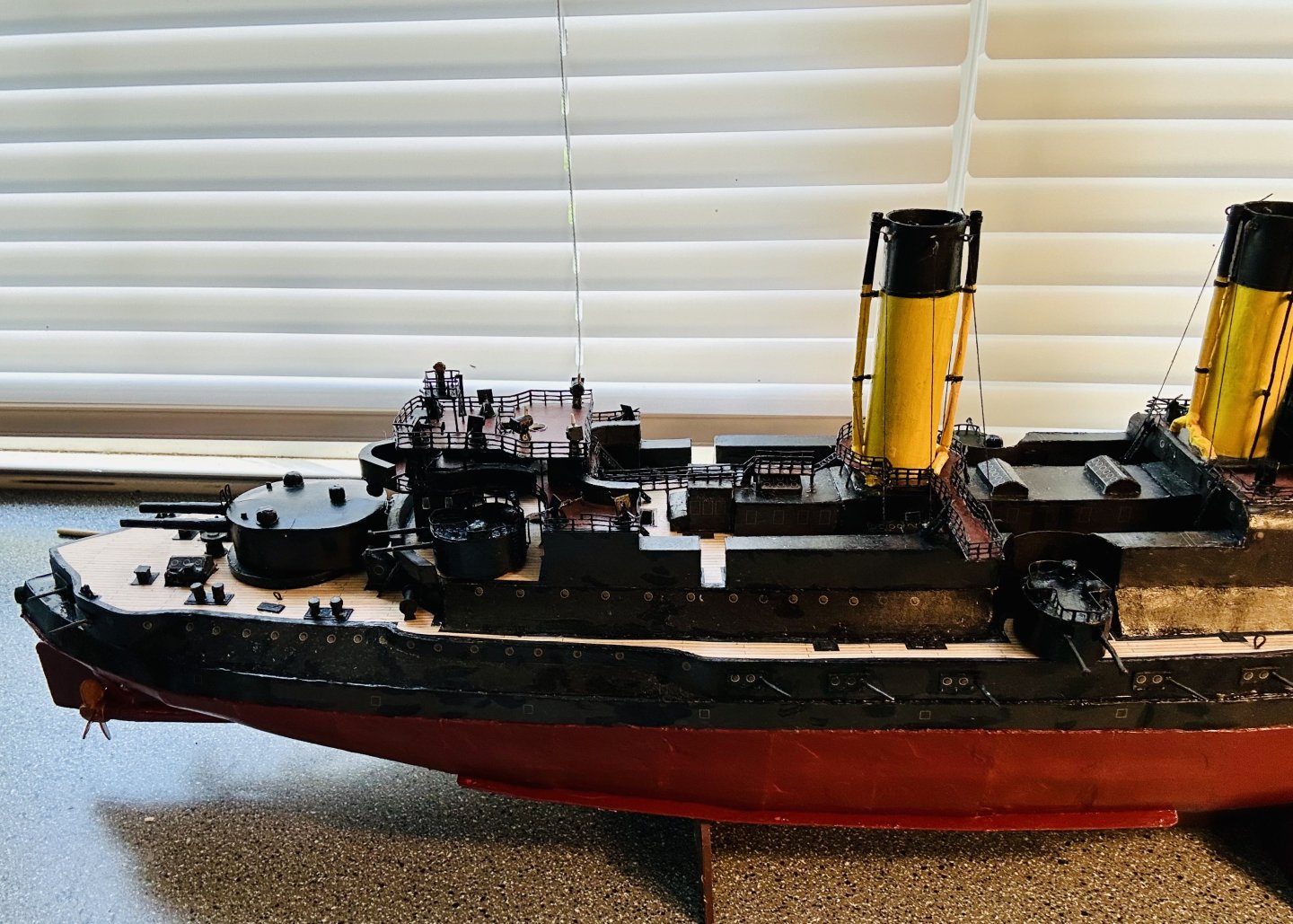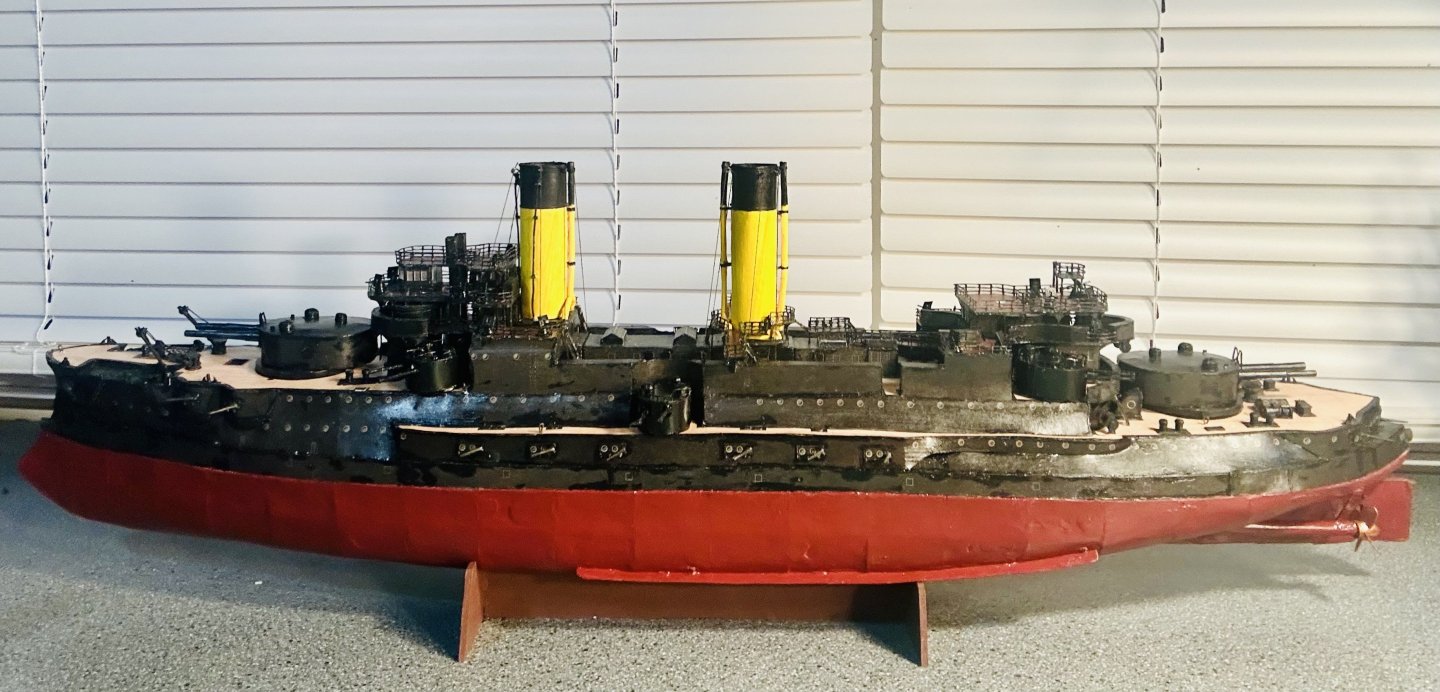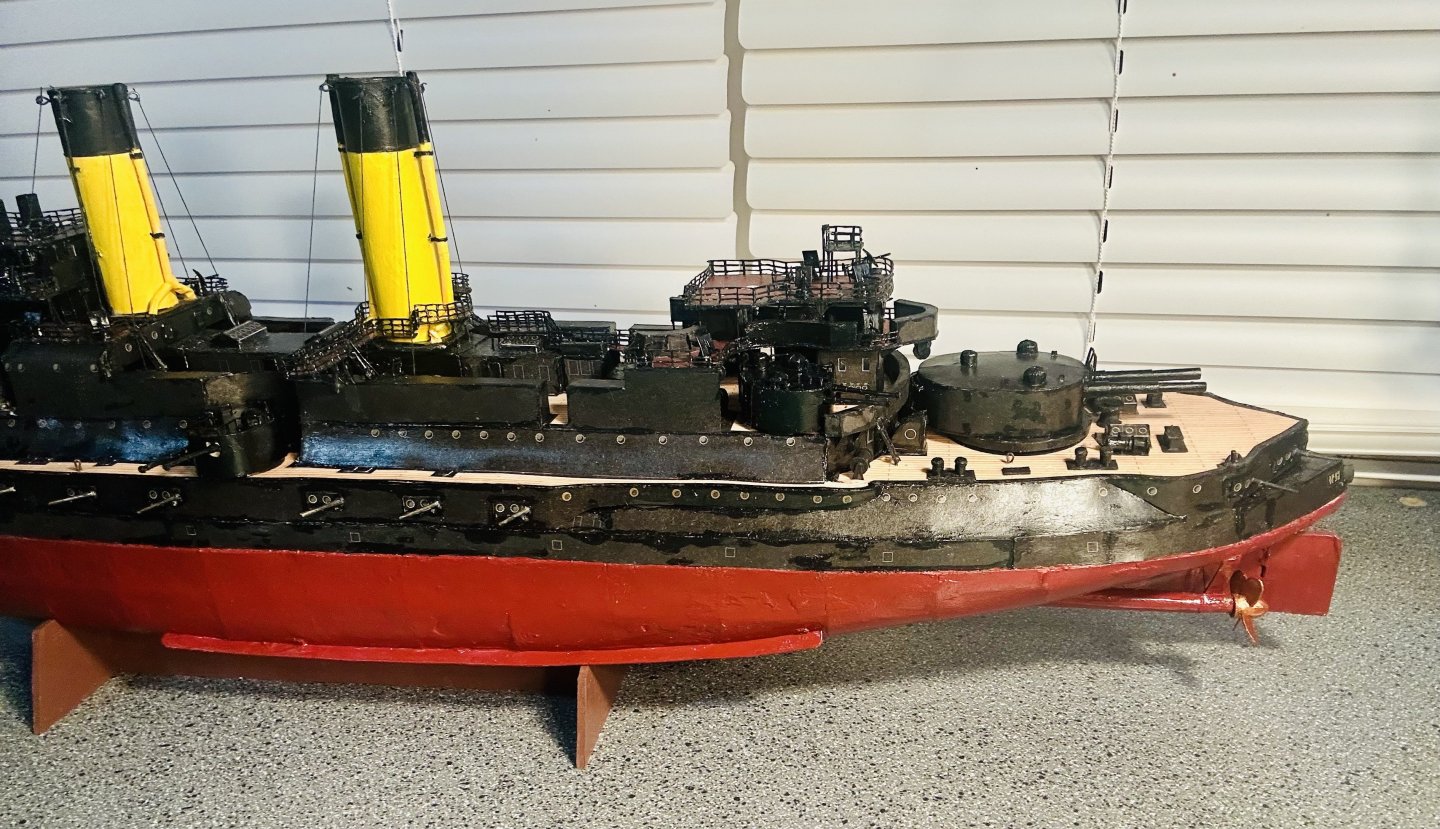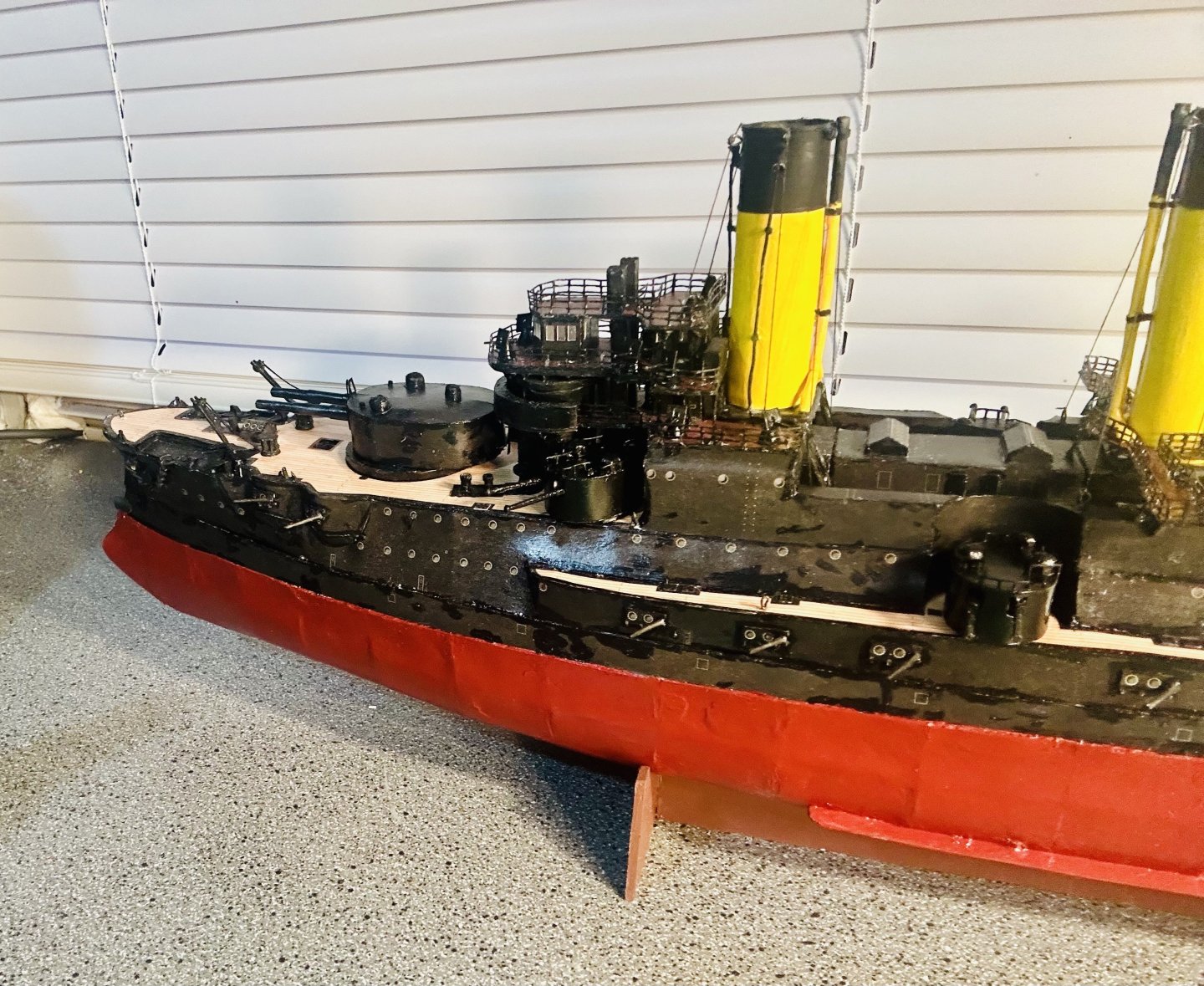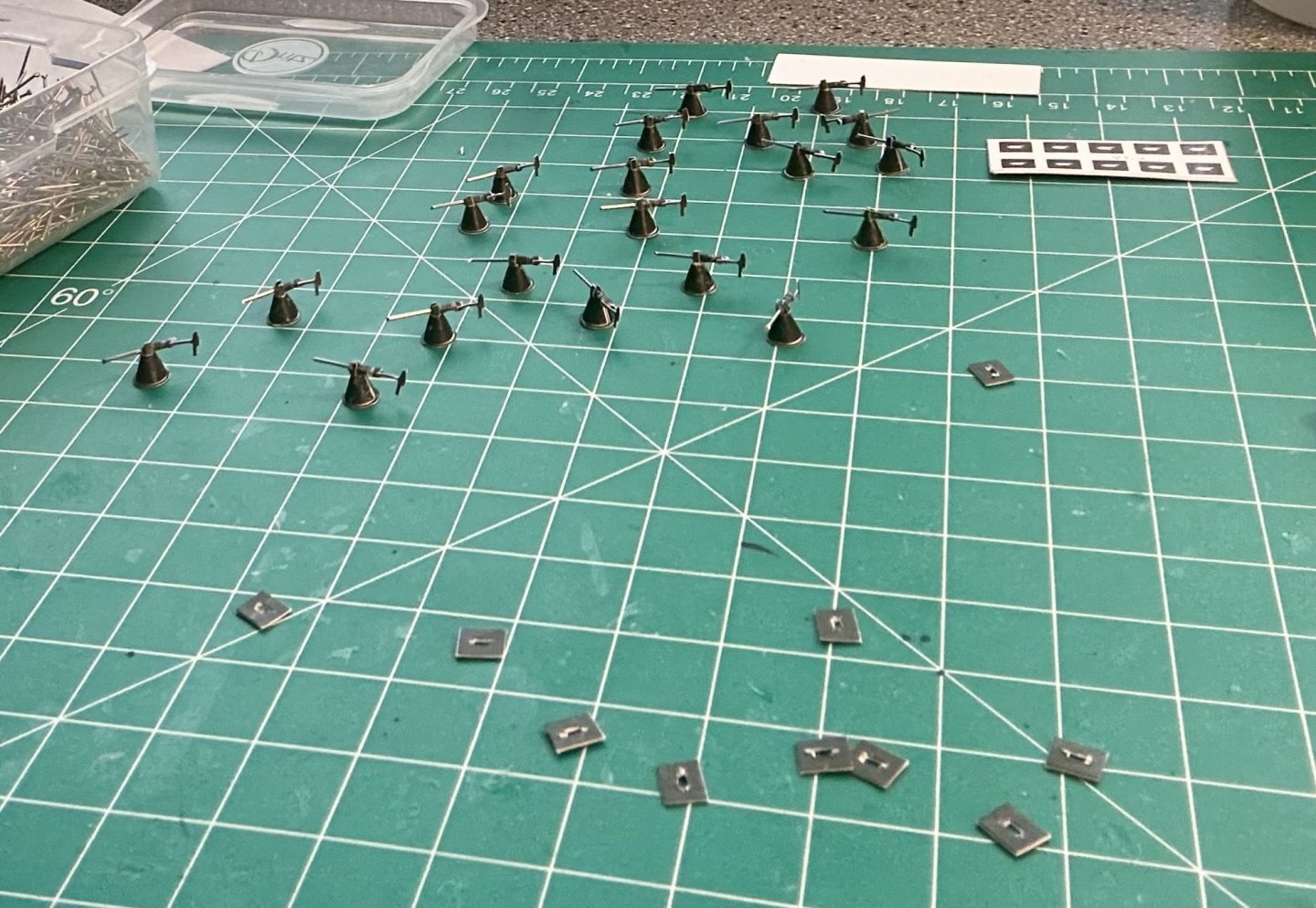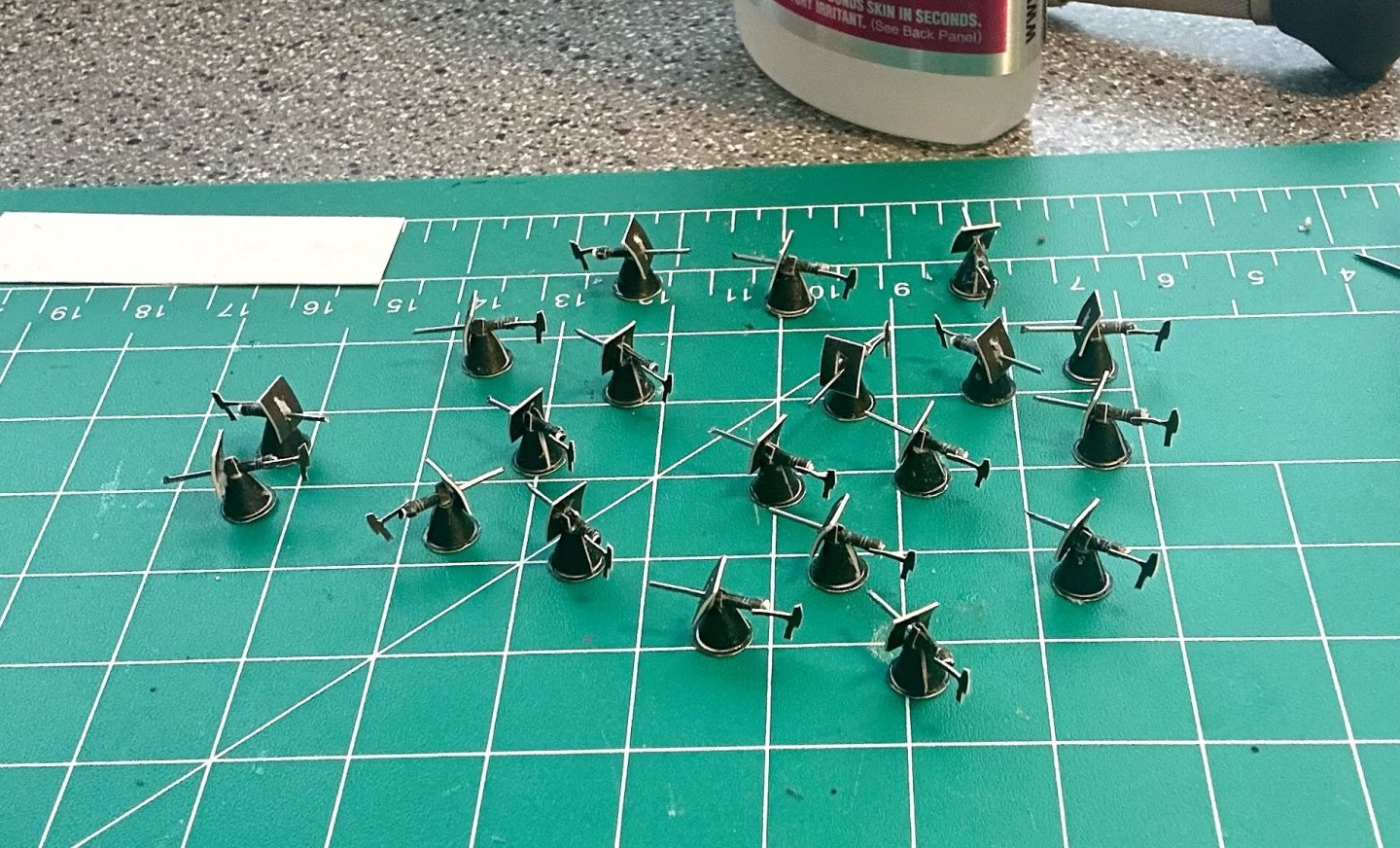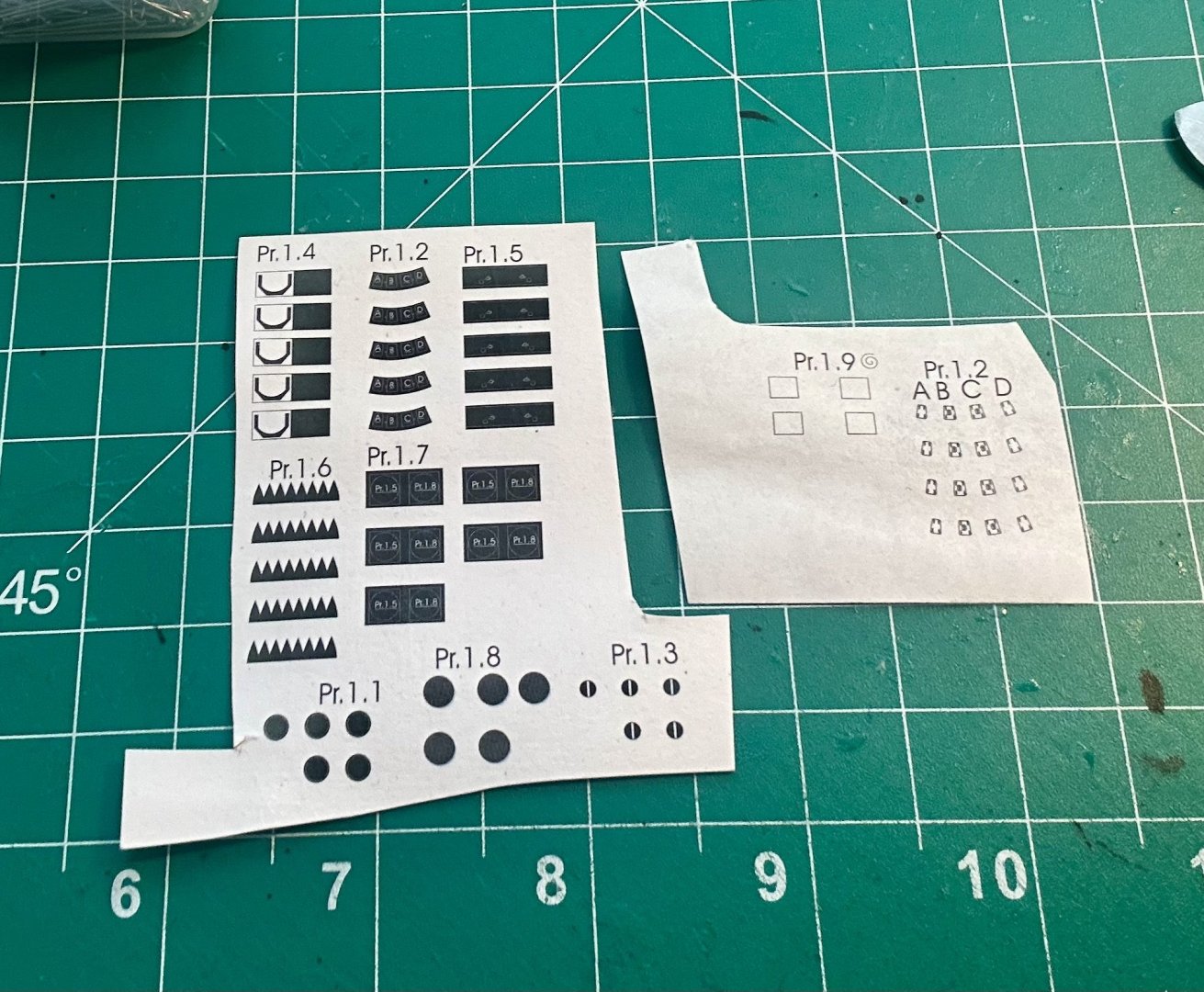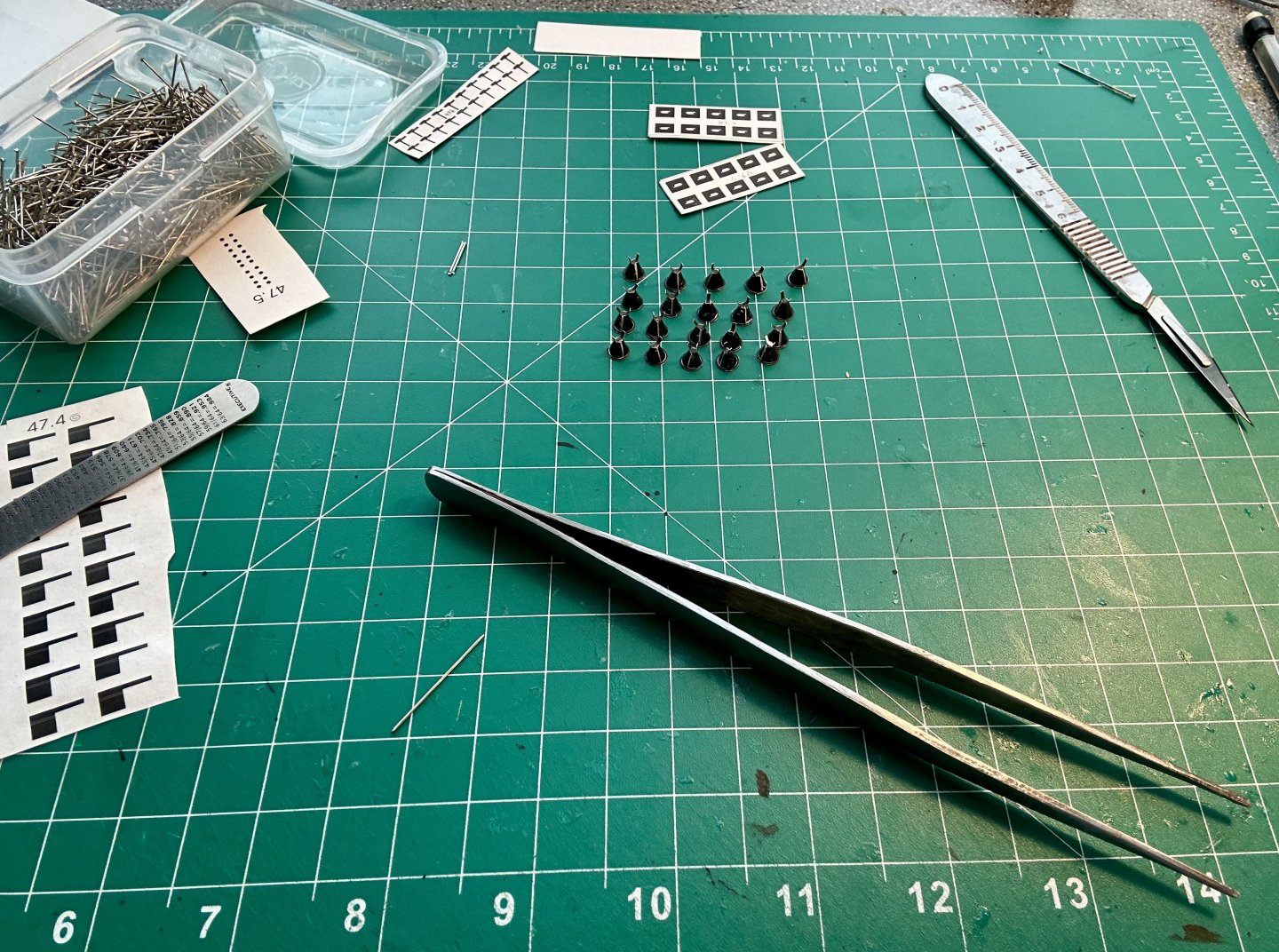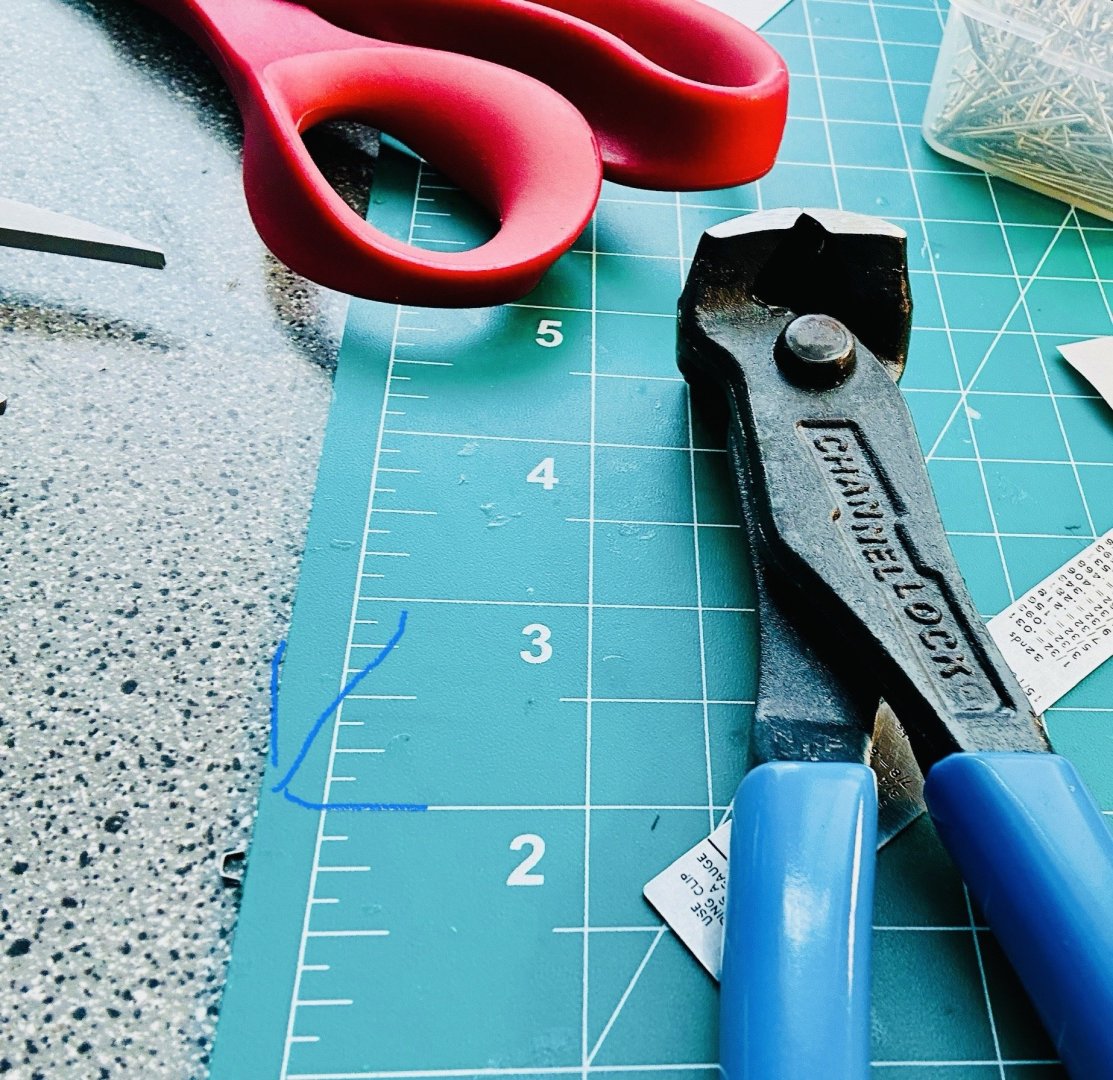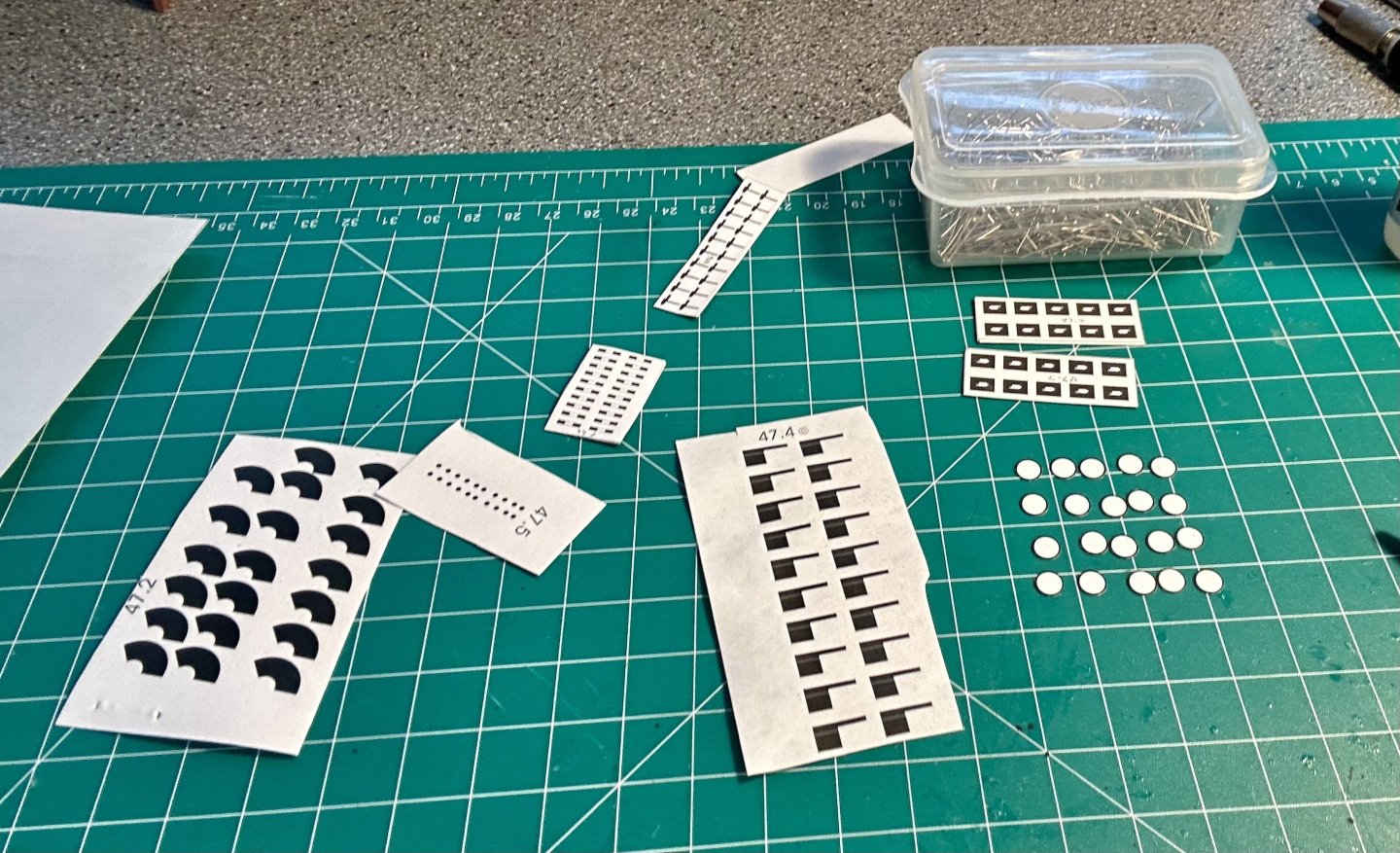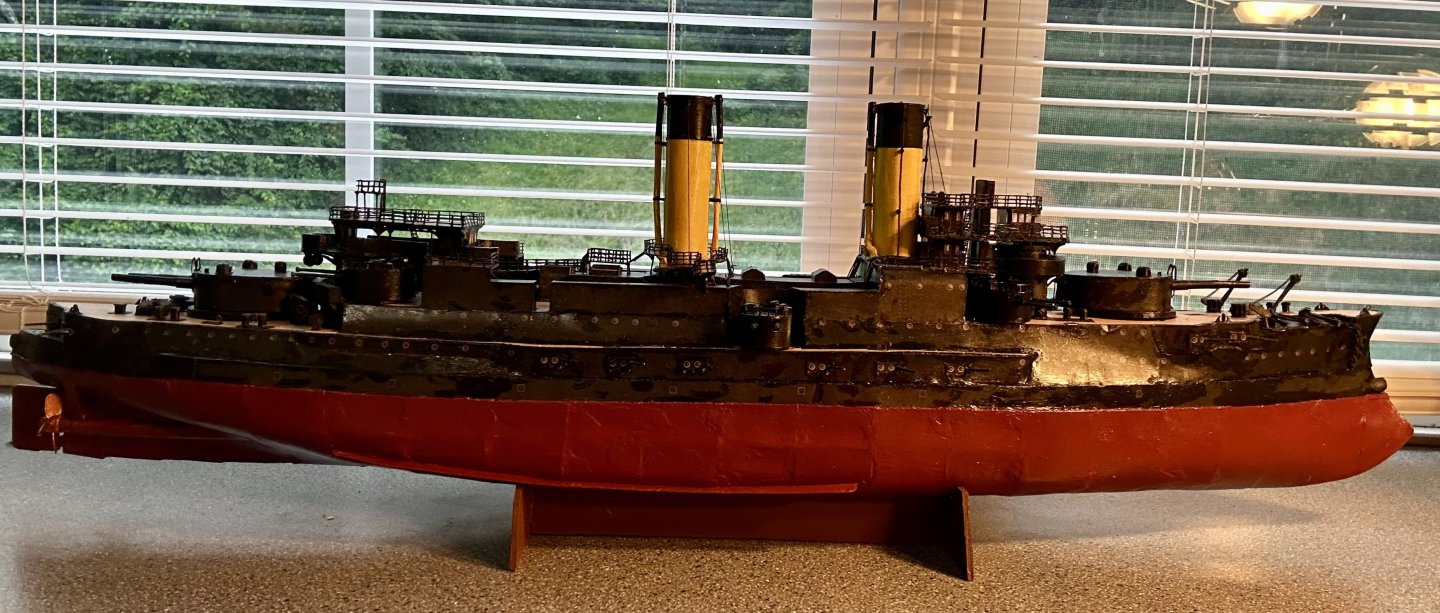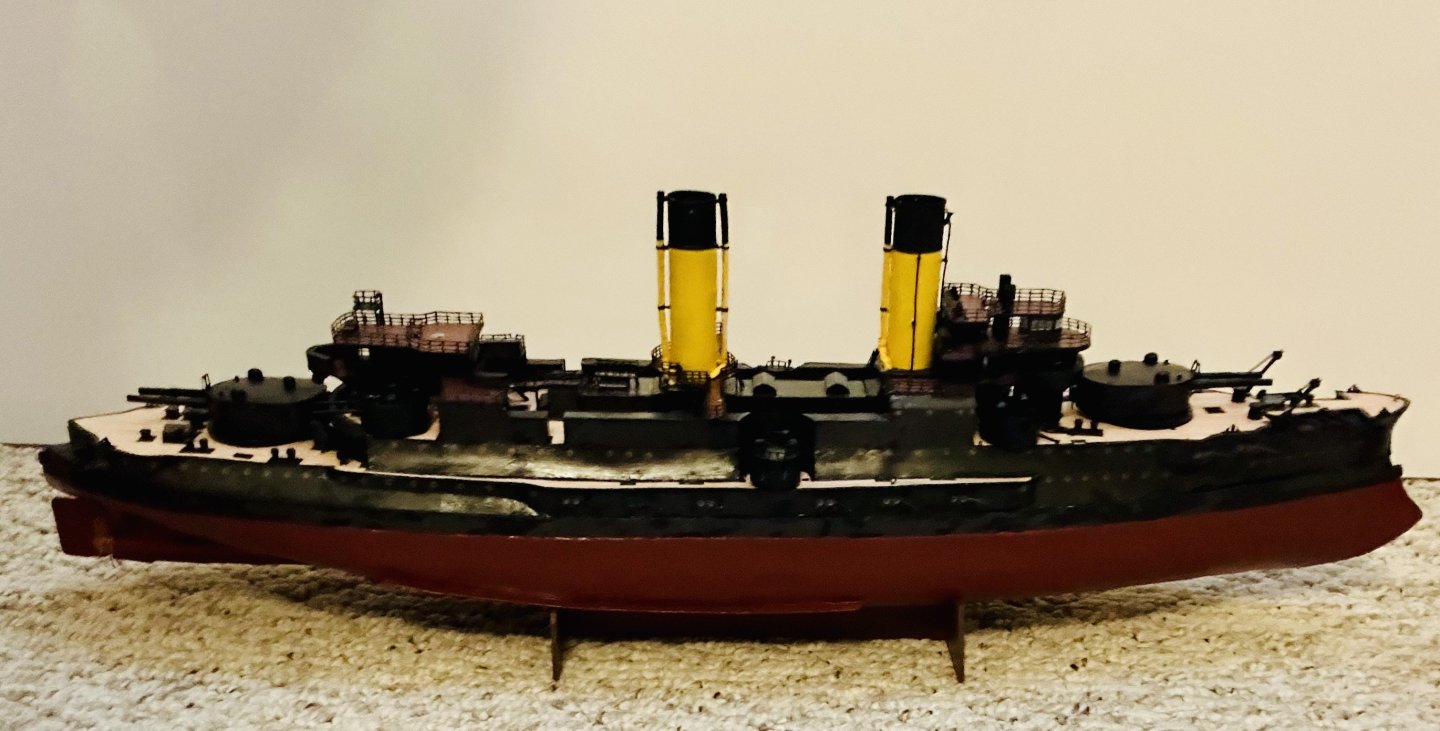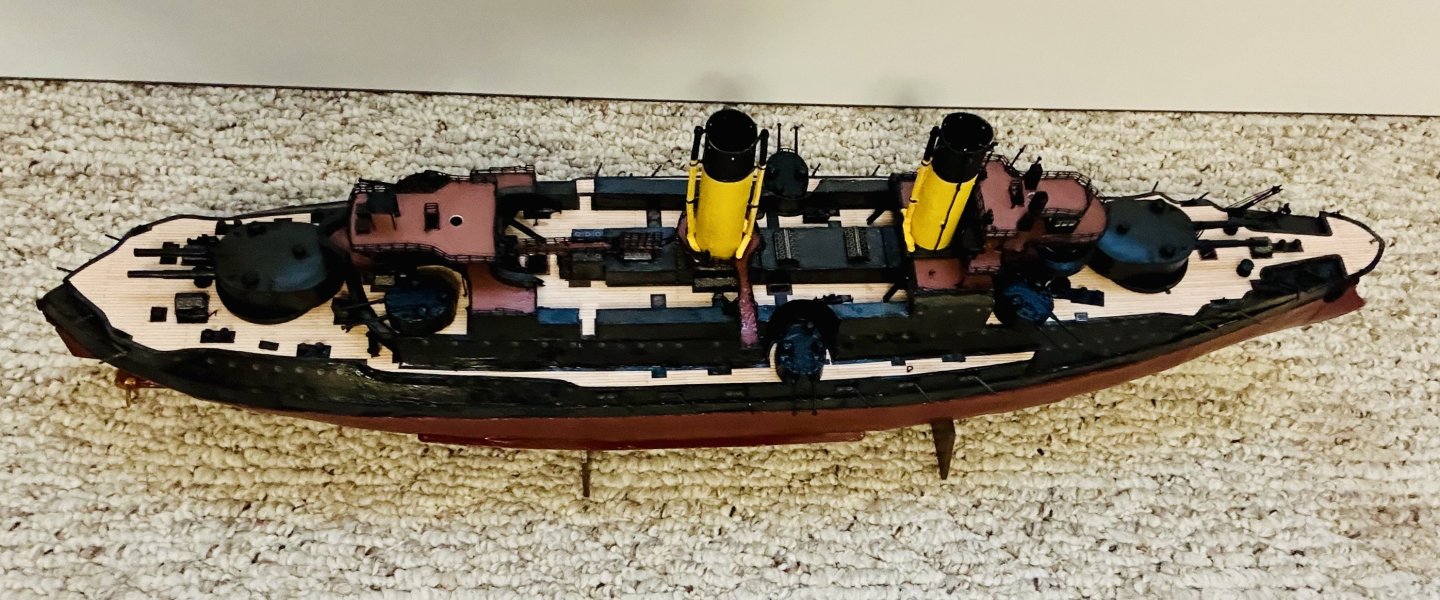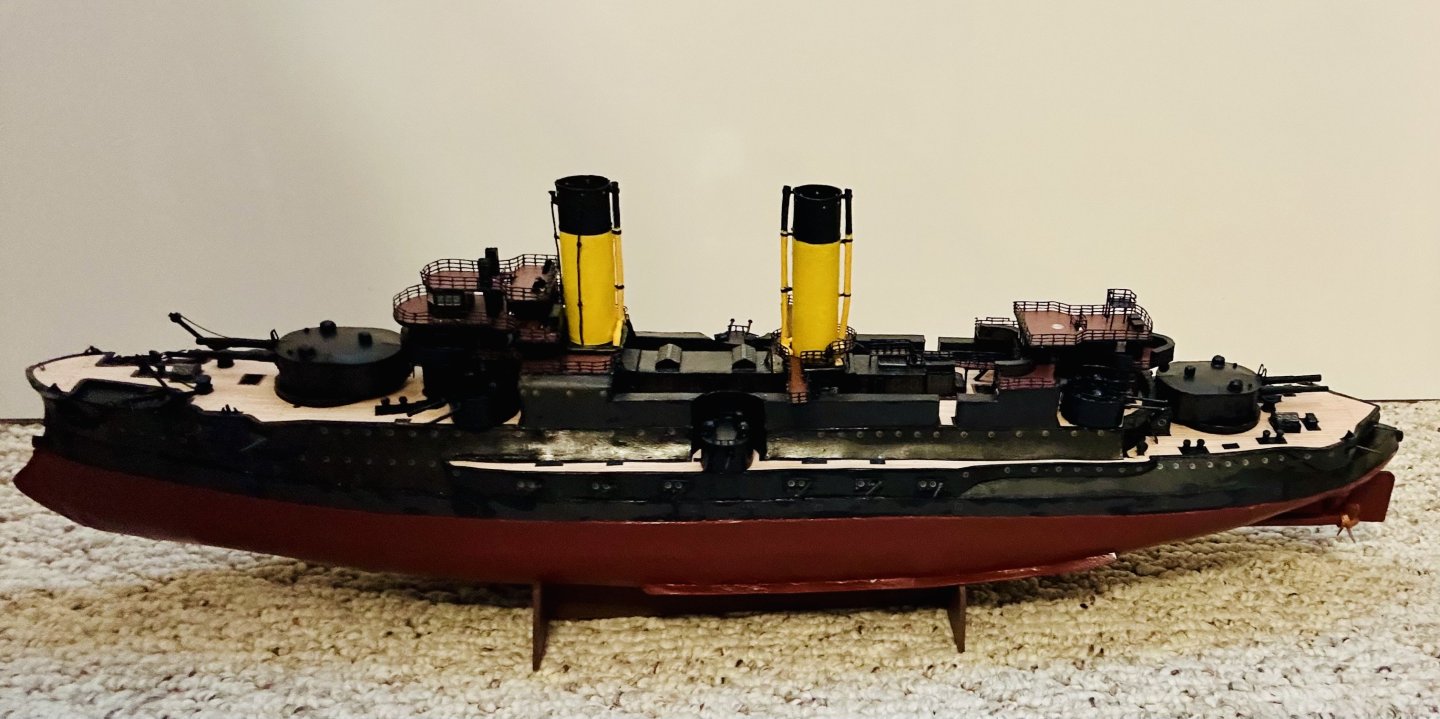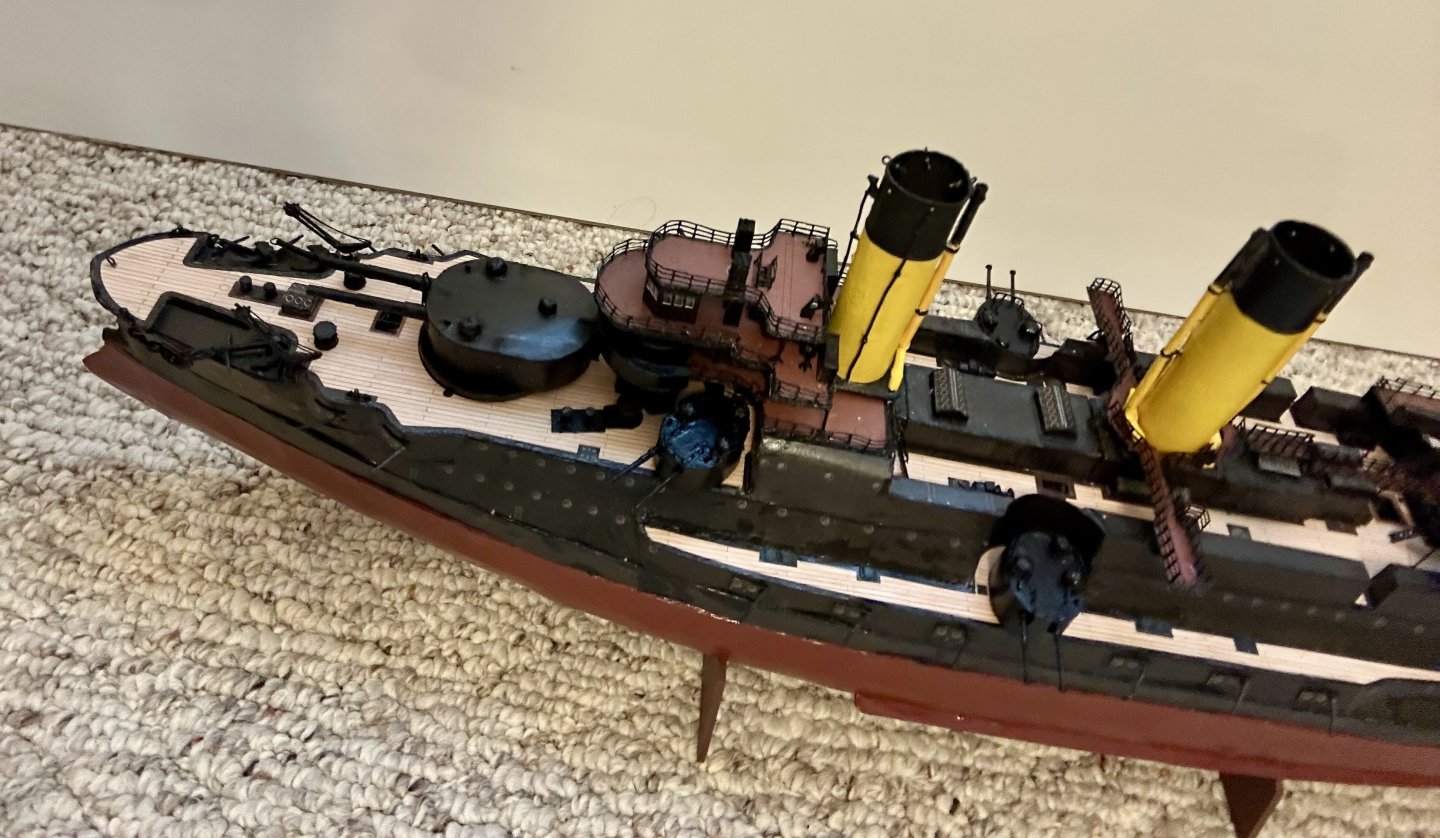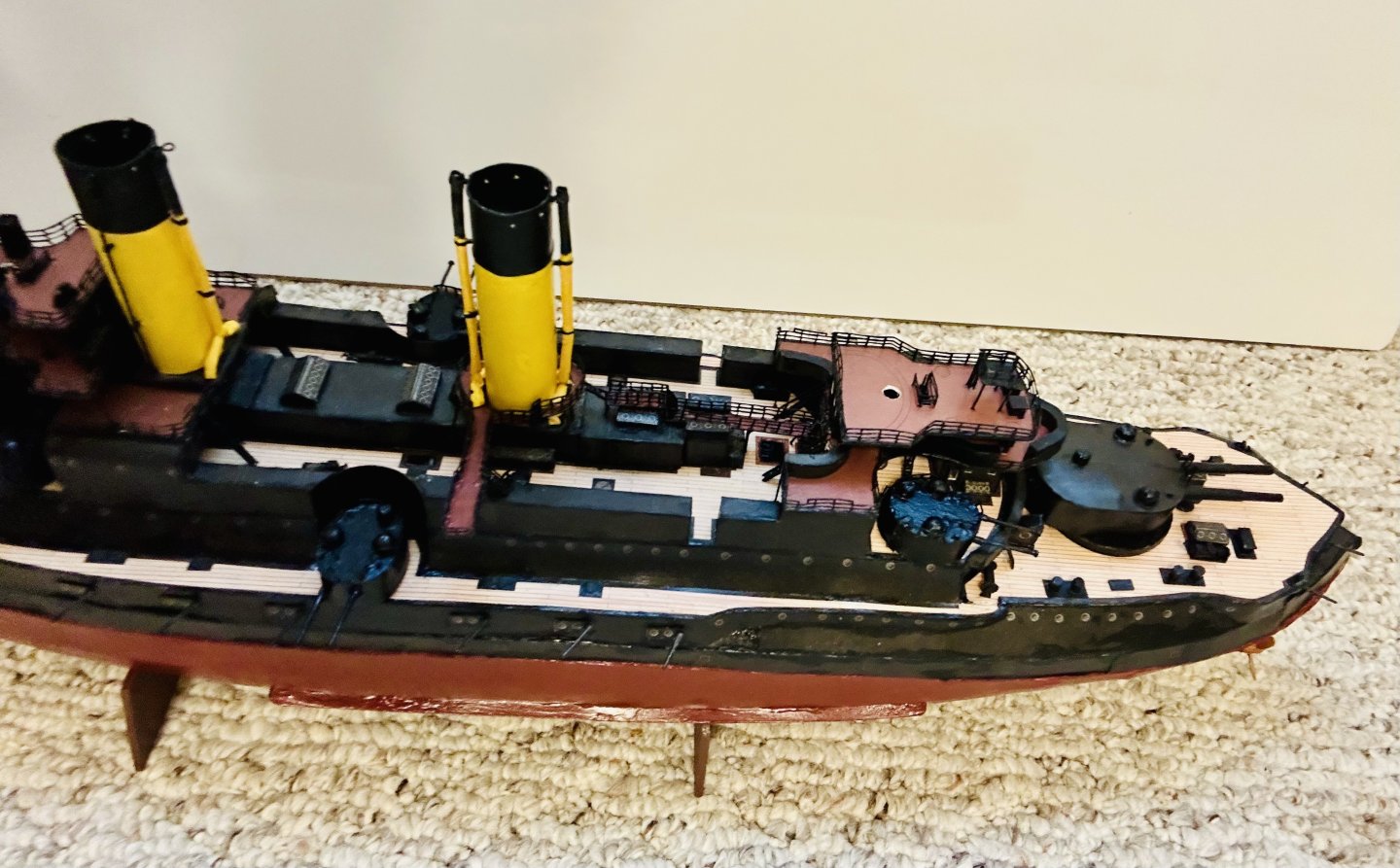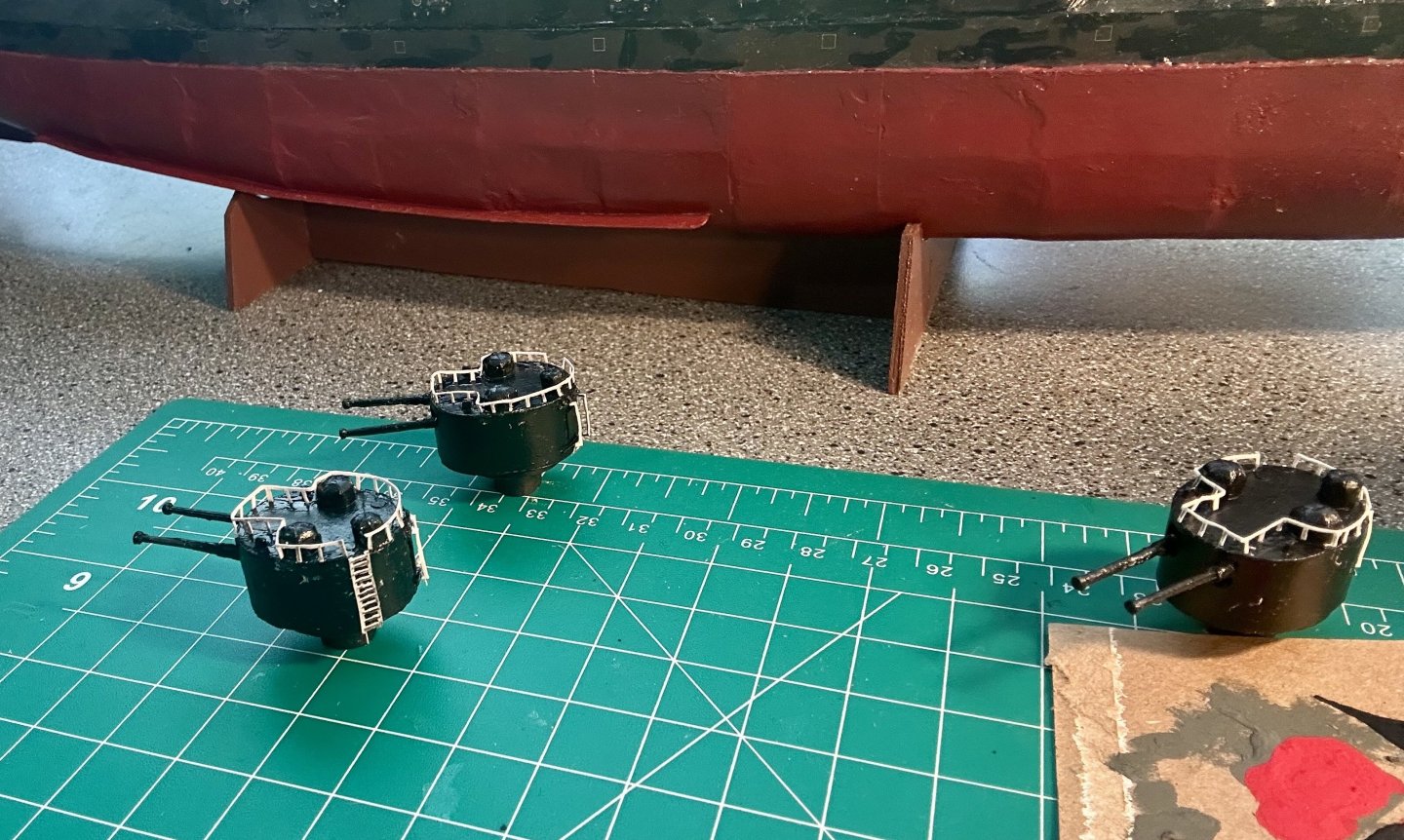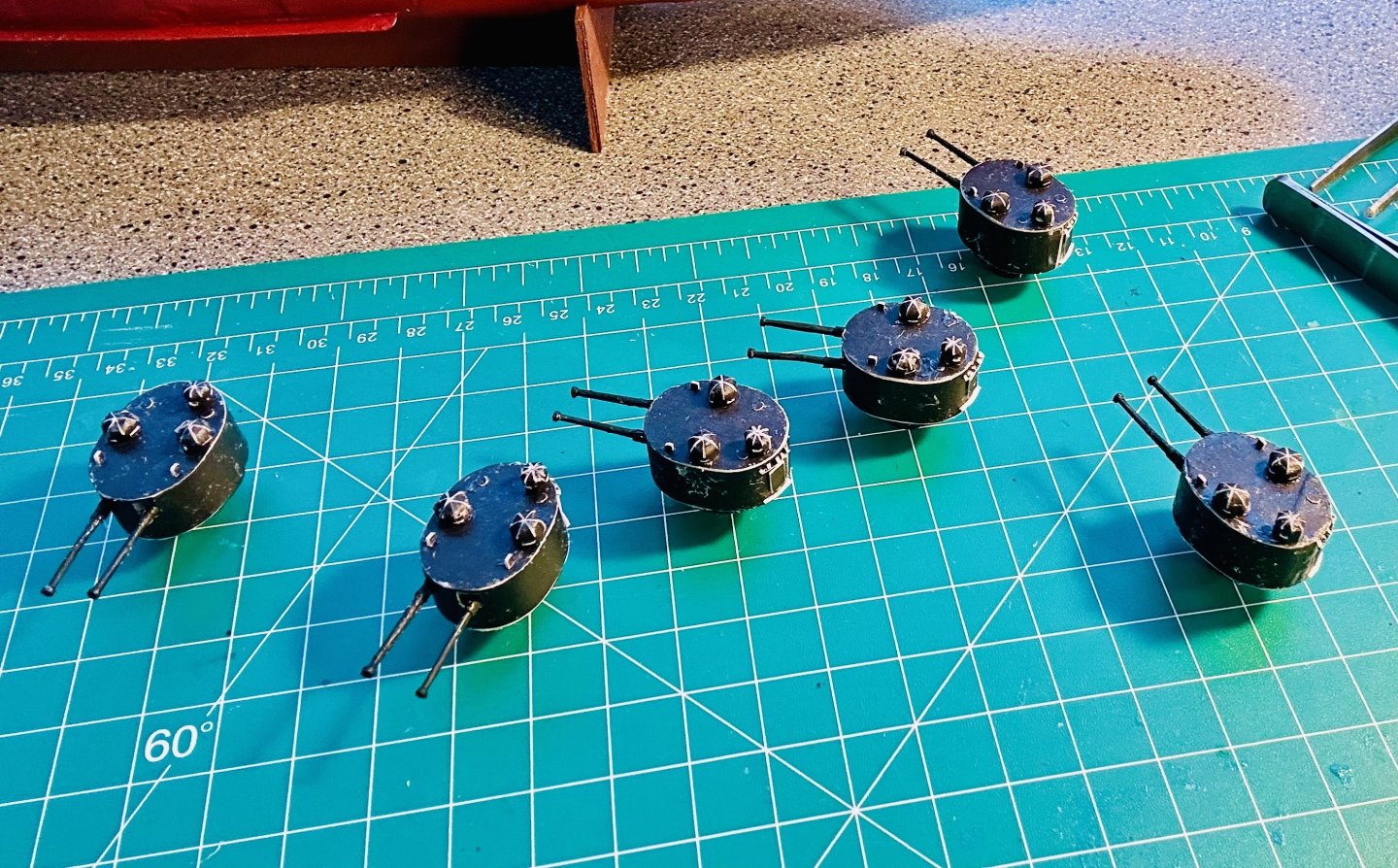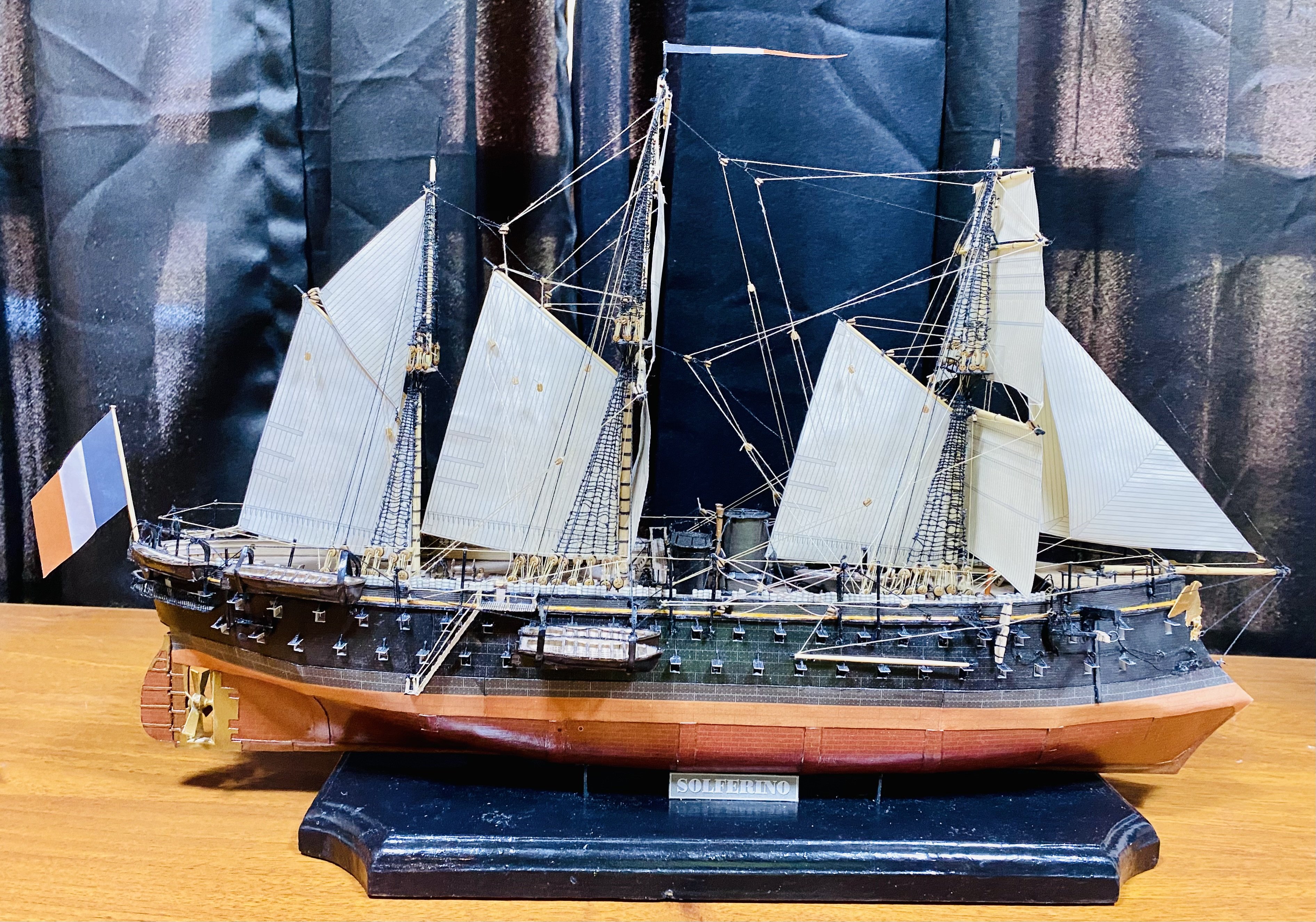
GrandpaPhil
NRG Member-
Posts
6,128 -
Joined
-
Last visited
Content Type
Profiles
Forums
Gallery
Events
Everything posted by GrandpaPhil
-
Steve, Thank you very much! The research that these models take you on is half the fun for me! OC, Thank you very much! Thank you to all who hit the “like” button or have just stopped by! I finished and installed all superstructure fittings! The foremast is carved and assembled and stepped in place! Here is a side on shot of the model: The foremast still needs some fittings, yards, a bit of paintwork and sealed. Then I can make the main mast and rig the model. I don’t like card or plastic masts. I always just carve my own, with a scalpel, out of wood, and paint them accordingly. It is interesting with the generational gaps and overlaps in technology with the pre-Dreadnoughts that meld early 20th/late 19th century technology with older fittings and structures.
- 288 replies
-
- Card
- Pre-Dreadnought
-
(and 3 more)
Tagged with:
-
I just finished assembling the last of the superstructure fittings! All five of the searchlights are made and installed! Here are the in progress pictures: The finished searchlights picture: And the installed pictures: I discovered that the track looking things on the upper tower decks are tracks for the searchlights. Lastly, here are the assembled peloruses: They need some paintwork after they dry. I also just realized what the aft observation platform was for. It is to put both peloruses at the same elevation for triangulation ranging, which now makes perfect sense. I am learning about modernish naval surface warfare as I go. One of the things about building models that I enjoy, is how much you learn about the subject that you are building, to include the related history.
- 288 replies
-
- Card
- Pre-Dreadnought
-
(and 3 more)
Tagged with:
-
Steve, Thank you very much! Thank you very much everyone for the likes and just for stopping by! The 47mm guns, which are Hotchkiss Rapid Firing Naval guns and are unrelated to the French ones used in the early part of the Second World War, are complete and installed! Next up are the five spotlights and two peloruses!
- 288 replies
-
- Card
- Pre-Dreadnought
-
(and 3 more)
Tagged with:
-
OC, Thank you very much! This has been a good challenge! Mark, Thank you very much! I have been learning a LOT with this build! The 47mm guns awaiting their shields: All 47mm guns are now assembled and awaiting painting: The search lights, some assembly required: In all, the Oryol is going well. I’m not going to lie, this thing is as complicated, and as difficult, as any other ship that I have ever built. The fitting out stage is always slow and takes a while. I am about 9 months into this model now, and I work on it about every day, for at least an hour. By comparison, the Prince de Neufchatel took me about seven months to complete. This one has definitely been a good challenge. I will be very pleased when the Oryol is completed.
- 288 replies
-
- Card
- Pre-Dreadnought
-
(and 3 more)
Tagged with:
-
Welcome!
-
Steve, Thank you very much! The deadeye will return after you replace it. Keith, Yes! That is why when I am not working from a kit, I always make extras as sacrificial parts! Chris, Yes, I did! That is when I realized the part had de-part-ed! Lol!
- 288 replies
-
- Card
- Pre-Dreadnought
-
(and 3 more)
Tagged with:
-
Still working on the 47’s: Have a funny experience to share. I had one of the little gun mount brackets fly out of the tweezers yesterday. I spent about five minutes looking for it, all around my work area. I decided that it must of gone into Part-Space and that I was spending more time looking for it than it would have taken to make another one. So, I made another one and chuckled to myself that the original would turn up later. I just found it: It’s the little bracket that the blue arrow is pointing to, lol.
- 288 replies
-
- Card
- Pre-Dreadnought
-
(and 3 more)
Tagged with:
-
Old model shipways USS essex (solid hull)
GrandpaPhil replied to Mike Esposito's topic in Wood ship model kits
What about the plans for the new Essex kit that Model Expo sells separately? I heard that there are problems with the bulkhead templates. -
Welcome!
-
20 x 47mm guns, some assembly required: The straight pins are stock for the gun barrels. I have already folded over all pieces that needed doubled or in the case of the shields, tripled. The Russians adapted this ship from a French design, hence the French whale-back design, so I’m assuming that the 47’s are the same weapon that the French, and those they supplied, used up until the beginning of World War II as an antitank gun. That line of reasoning would also indicate that the 75mm guns on the hull casemates were the same weapon that the French used as artillery up until the beginning of World War II as well. They weren’t as good as Krupp, but then nobody out-Krupped Krupp until the modern day.
- 288 replies
-
- Card
- Pre-Dreadnought
-
(and 3 more)
Tagged with:
-
New to the Wooden Ship Assembly/Build Community
GrandpaPhil replied to rturcic72's topic in New member Introductions
Welcome! -
@Keith Black, Thank you very much! The stack stays are up and installed (first actual rigging of this model): Moving on to the 47mm guns and the search lights!
- 288 replies
-
- Card
- Pre-Dreadnought
-
(and 3 more)
Tagged with:
-
@Keith Black, @Coyote_6 and @king derelict, thank you all very much! Thank you to all who have hit the like button or just stopped by! Those railings are quite time consuming, but worth it. It lets me make “photoetched” parts without the photoetch. The turrets definitely gave me a run for my money, but I am very happy with how they turned out. Here is the Oryol with the secondary battery complete and installed! I am currently working on installing eyebolts to take the rigging. Then I will rig the stacks, make and install the 47mm guns and searchlights, install and rig the masts/yards, add the ship’s boats, add the rest of the fittings away from the main superstructure to include the hull fittings and then add the flags, tentatively in that order. I’m working from the inside out to avoid having to work in an any more enclosed space than I have to.
- 288 replies
-
- Card
- Pre-Dreadnought
-
(and 3 more)
Tagged with:
-
Greetings from Washington state, USA
GrandpaPhil replied to Paul B.'s topic in New member Introductions
Welcome! -
Mark, Thank you very much! Half of the turrets are fully assembled with railings, handles and ladders now: The shaping of those railings is tricky. They still need painted and sealed.
- 288 replies
-
- Card
- Pre-Dreadnought
-
(and 3 more)
Tagged with:
-
Alan, Thank you very much! The main structure of all six secondary turrets are done: I need to clean them up, paint them all and make/add ladders & railings. These have been very slow going. Each of those turrets will have about fifty pieces each when complete. That makes for approximately 300 pieces between the six turrets. That’s just part of these models though. I am enjoying this build very much! It is a good challenge!
- 288 replies
-
- Card
- Pre-Dreadnought
-
(and 3 more)
Tagged with:
-
I brush on the Folk Art Clear Primer. It works great!
- 37 replies
-
- Baltimore
- heinkel models
-
(and 2 more)
Tagged with:
-
Jeff, The Baltimore turned out great! I agree about most card model instructions leaving a lot open to interpretation. I have been coating both sides of a card model with sealant (the generic Folk Art variety from Hobby Lobby or Michael’s) prior to cutting anything out. That saves a LOT of aggravation with small/intricate parts delaminating.
- 37 replies
-
- Baltimore
- heinkel models
-
(and 2 more)
Tagged with:
-
Flying Sd.Kfz.222 by RGL - HobbyBoss - 1/35 - PLASTIC
GrandpaPhil replied to RGL's topic in Non-ship/categorised builds
Incredible work!
About us
Modelshipworld - Advancing Ship Modeling through Research
SSL Secured
Your security is important for us so this Website is SSL-Secured
NRG Mailing Address
Nautical Research Guild
237 South Lincoln Street
Westmont IL, 60559-1917
Model Ship World ® and the MSW logo are Registered Trademarks, and belong to the Nautical Research Guild (United States Patent and Trademark Office: No. 6,929,264 & No. 6,929,274, registered Dec. 20, 2022)
Helpful Links
About the NRG
If you enjoy building ship models that are historically accurate as well as beautiful, then The Nautical Research Guild (NRG) is just right for you.
The Guild is a non-profit educational organization whose mission is to “Advance Ship Modeling Through Research”. We provide support to our members in their efforts to raise the quality of their model ships.
The Nautical Research Guild has published our world-renowned quarterly magazine, The Nautical Research Journal, since 1955. The pages of the Journal are full of articles by accomplished ship modelers who show you how they create those exquisite details on their models, and by maritime historians who show you the correct details to build. The Journal is available in both print and digital editions. Go to the NRG web site (www.thenrg.org) to download a complimentary digital copy of the Journal. The NRG also publishes plan sets, books and compilations of back issues of the Journal and the former Ships in Scale and Model Ship Builder magazines.


